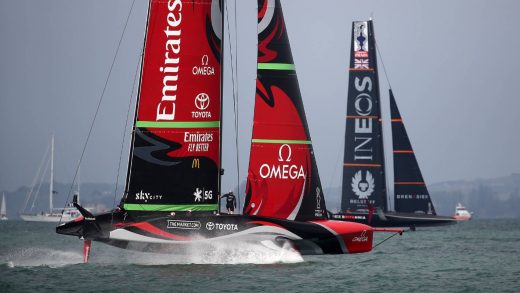
EXPLAINER: The “One China” policy is in the news this week with US Speaker Nancy Pelosi’s visit to Taiwan. China views this as further proof that the United States is backing away from its recognition of “One China” policy. New Zealand also recognises Beijing’s “One China” policy. But there are a lot of misunderstandings about this policy, so here we break it down.
First, some history
The Communists, led by Mao Zedong, had been vying with the ruling Nationalists (the Kuomintang, or KMT), who were led by Chiang Kai-shek, starting from 1927. But this exploded into a proper civil war with the defeat of Japan and the end of World War II in 1945.
The Chinese Communist Party, with its People’s Liberation Army, was victorious, establishing the People’s Republic of China in 1949. Chiang and the KMT fled to Taiwan, establishing the Republic of China.
It’s important to note here that while Taiwan was historically a province of China, it has never been a part of the Communist-led People’s Republic of China.
READ MORE:
* Why China wants to take control of Taiwan, and why New Zealand should care
* Taiwan is becoming a flashpoint for China and the West – how does New Zealand respond?
* Smarter ways to oppose human rights abuses in China
From 1949, both sides claimed to be the legitimate government of China, but the United Nations and by many non-Communist states, including New Zealand, recognised the Republic of China. That all began to change, however, with US President Richard Nixon’s rapprochement with Beijing in the early 1970s.
New Zealand recognises China and recognises China’s view on Taiwan
While Nixon went to China in 1972, the United States didn’t actually establish formal diplomatic relations until 1979, when Jimmy Carter was president.
But New Zealand established diplomatic relations with China in 1972 – we will mark the 50th anniversary of this in December. At the time, New Zealand’s government said it “could not ignore one quarter of humanity”.
In switching diplomatic allegiances, New Zealand recognised the People’s Republic of China and said we acknowledged the position of the Chinese Government in Beijing that Taiwan was “an inalienable part of the territory of the People’s Republic of China”. We didn’t say we agreed with that position, just that we accepted that this was Beijing’s position.
Successive New Zealand governments, regardless of their political stripe, have maintained the same basic policy since 1972.
Getty Images
Participants wearing Red Army uniforms recreate the Long March, (1934-35), to celebrate the 100th anniversary of the founding of the Communist Party of China. (Photo by Getty Images)
We still have relations with Taiwan
This has enabled us, and other like-minded countries, to maintain a kind of strategic ambiguity regarding Taiwan. We don’t have official diplomatic relations but we do have an interests section in Taipei, called the “Commerce and Industry Office,” and instead of an ambassador, it has a “director”, a role currently filled by career diplomat Mark Pearson. There are often lots of New Zealand diplomats in Taiwan – those preparing for postings in China do their language training there.
Taiwan, a country of 23 million people, is now our sixth-largest trading partner, with goods exports growing a whopping 27.1% to $1.6 billion in the year to June. This is partly thanks to a free trade agreement with Taiwan, the wordily titled “Agreement between New Zealand and the Separate Customs Territory of Taiwan, Penghu, Kinmen, and Matsu on Economic Cooperation,” or ANZTEC, signed in 2013.
As former Ministry of Foreign Affairs and Trade deputy secretary Dick Grant points out, deft dealing with China allowed New Zealand to enter free trade agreements with Hong Kong, and another with Taiwan – the only OECD country to do so – all the while not deviating from its adherence to the One China policy. “This shows a degree of diplomatic skill in managing the difficulties involved, and suggests a certain degree of experience which will be helpful in the future,” he said.
Chiang Ying-ying/AP
President Tsai Ing-wen of Taiwan.
The US also recognised the “One China” policy in 1979
When the US recognised the People’s Republic of China in 1979, it also adopted a policy of recognising China’s “One China” principle. Although, to compensate for “de-recognising” Taiwan, Congress passed the Taiwan Relations Act in 1979 to protect the significant US security and commercial interest in Taiwan, wrote Michael Green of the Center for Strategic and International Studies think-tank.
To this day, the US “One China” position stands: the United States recognises the People’s Republic of China as “the sole legal government” of China but only acknowledges the Chinese position that Taiwan is part of China.
Beijing is concerned that the United States is now backing away from this policy – a fear fuelled by President Joe Biden’s repeated gaffes and heightened by Pelosi’s visit.
Policy vs principle
This is an important distinction. The People’s Republic of China maintains a “One China principle” that there is only one sovereign state called China, and that it is the sole legitimate government of that China. The “One China policy” is the policy of countries – like New Zealand and the United States – to recognise the PRC’s principle that it is the legitimate China and that it considers Taiwan to be part of it.
As China has grown richer, it has used its economic might to convince – some might say coerce – countries into dropping their diplomatic recognition of Taiwan in favour of recognising China.
Over recent years, Beijing has steadily been picking off Taiwan’s remaining diplomatic partners, many of them in the Pacific, including Kiribati and the Solomon Islands. There are only 13 countries out of the 193 United Nations members that have full diplomatic relations with Taiwan – and they’re hardly international power players. The list includes countries like Belize and Eswatini and, in our area, Nauru and Tuvalu.
Taiwan Ministry of Foreign Affairs/via AP
In this photo released by the Taiwan Ministry of Foreign Affairs, US House Speaker Nancy Pelosi, centre pose for photos after she arrives in Taipei, Taiwan, Tuesday, Aug. 2, 2022.
Casting Taiwan into the diplomatic wilderness
Taiwan, or the Republic of China, existed in a strange limbo since countries started shifting their diplomatic relations to an economically burgeoning China. It never formally declared independence, and the Chinese Communist Party has threatened to use force if it ever did so.
China strongly objects to any recognition of Taiwan, which is why it participates in the Olympic Games and the World Trade Organisation as “Chinese Taipei”.
China has also had Taiwan excluded from World Health Organisation meetings about the coronavirus pandemic – even though Taiwan has been held up as a poster child for its response to the pandemic. New Zealand also backed Taiwan gaining observer status at the World Health Organisation, despite Beijing’s protests.
Ng Han Guan/AP
A security guard stands near a sculpture of the Chinese Communist Party flag at the Museum of the Communist Party of China in Beijing.
There are commercial implications too
Woe betide any company that suggests that Taiwan is its own country. This kind of “error” is hugely consequential in a country of 1.4 billion increasingly rich and aspirational consumers.
The Marriott hotel chain had its website shutdown in China after it listed Taiwan, Hong Kong, Macau and Tibet as individual nations in an online survey it sent to customers. The company apologised and said it did not support “separatist movements” in China.
Fashion companies including Dior, Valentino, Calvin Klein and Coach have all apologised for listing Taiwan and Hong Kong as separate countries or regions on its website.
McDonald’s apologised after showing an advertisement, in Taiwan, that included a two-second clip of a student ID card that showed Taiwan as a country. “We have always supported the One-China policy and continue to uphold Chinese territorial sovereignty,” it said.


